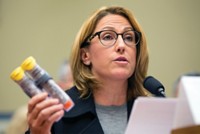Advertisement
Grab your lab coat. Let's get started
Welcome!
Welcome!
Create an account below to get 6 C&EN articles per month, receive newsletters and more - all free.
It seems this is your first time logging in online. Please enter the following information to continue.
As an ACS member you automatically get access to this site. All we need is few more details to create your reading experience.
Not you? Sign in with a different account.
Not you? Sign in with a different account.
ERROR 1
ERROR 1
ERROR 2
ERROR 2
ERROR 2
ERROR 2
ERROR 2
Password and Confirm password must match.
If you have an ACS member number, please enter it here so we can link this account to your membership. (optional)
ERROR 2
ACS values your privacy. By submitting your information, you are gaining access to C&EN and subscribing to our weekly newsletter. We use the information you provide to make your reading experience better, and we will never sell your data to third party members.
Business
High Noon At The Pharma Pricing Corral
A wrangle over costly hepatitis C drugs portends a transformation in health care reimbursement
by Rick Mullin
February 16, 2015
| A version of this story appeared in
Volume 93, Issue 7
Reorganize R&D in pharmaceuticals? Not a problem. It hurt, but faced with petering pipelines and patent expirations on top-selling drugs, major drug companies moved quickly over the past three years to consolidate operations. They closed labs, slashed research staff, and sold off noncore ventures. They replaced those operations by forming partnerships with academic labs and licensing or acquiring promising drug candidates from small biotech firms, hardly skipping a beat on innovation.
Reorganize getting paid in the drug industry? That’s a problem. In fact these days, the business appears to be at crisis point, as the first entries in a new generation of high-priced, highly effective drugs raise alarm and generate pushback from patients, insurance providers, and Congress.
Much of the attention is on two expensive new drugs for hepatitis C—Gilead Sciences’ Sovaldi and AbbVie’s Viekira Pak. Also of concern is a related deal between AbbVie and Express Scripts, a pharmacy benefits management firm, or PBM. Rebelling against Sovaldi’s $84,000-per-treatment price tag, Express Scripts said it would offer Viekira Pak at a significant, but undisclosed, discount and exclude Sovaldi from its formulary. In response, Gilead cut a similar deal with the drugstore chain CVS.
The U.S. Senate, also startled by Gilead’s asking price, convened a committee last year to investigate the drug’s cost. Meanwhile, patient advocates have come forward with concerns over the steep price of highly effective new drugs not only for hepatitis C but also for cancer and a variety of rare diseases. Moreover, they view the likelihood of formulary exclusion via deals between drug companies and PBMs as threatening access to treatment.
It can be argued that nothing out of the ordinary is happening. Products that differentiate themselves from others in any market command high prices—consider the furor over a new smartphone—and two such products will often battle head-to-head for market share. Vying for exclusive deals with payers is a time-honored means of doing battle in many industries.

Indeed, Gilead’s disclosures about such deals in its recent earnings statement led stock analysts at Morgan Stanley to estimate the firm’s average price for Sovaldi and Harvoni, another hepatitis drug, at $51,000 to $52,000 when discounts are taken into consideration.
But drugs are not smartphones. Their critical role in people’s lives, the means by which their value is calculated, the method established for payment, and drugmakers’ outsized expectations for return on investment define a unique economy of access and reimbursement—one that industry watchers claim is no longer sustainable and is in need of change.
The cost of developing and commercializing a new drug has risen to $2.6 billion, a 145% increase, corrected for inflation, over the past 10 years, according to a recent report from the Tufts Center for the Study of Drug Development. And drug companies want to recoup that investment.
But the price of new therapies is increasingly determined by estimates of savings to the health care system over an extended period of time, a calculation that often yields a significantly higher figure than the mere investment cost. In short, if an effective new drug cures a patient of a chronic disease, the cost benefit of not having that person as a patient is factored into the treatment cost. As drugs impacting underserved therapeutic areas emerge, some fear that price and volume will combine to overwhelm the annual budgets of insurance companies and other payers.
“I think of this as pressure building up,” says Glen Giovannetti, global life sciences leader at the consulting firm Ernst & Young, of the attention garnered by the hepatitis C drugs in recent weeks. Although Giovannetti sees nothing fundamentally new in dealings between the drug companies and insurers, he says there is cause for concern over the rise of formulary exclusion as more breakthrough drugs enter the market. According to Giovannetti, Express Scripts is “clearly sending a message” that it is also looking to form exclusive pacts with drugmakers over future cancer treatments.
But the battle over drug pricing may also be a distraction from a more important issue, according to Robert M. Goldberg at the Center for Medicine in the Public Interest, a health care policy research organization. “Discussions about what is best for patients always circle back to outrage over high prices,” Goldberg says. “But this is nothing new. We have been fighting about drug prices since the snake oil salesmen pulled their wagons to town. We rarely have a discussion about value.”
Some of today’s new drugs, he says, are delivering more value to patients and their families than the drugs of 10 years ago did, which means big changes across the health care landscape. “There is less and less economic return going to the traditional institutions, like the insurance companies and the hospitals,” Goldberg says. “These medicines are doing to this business model what digital information did to the recording industry. They are decimating it.”
Jump to Topics:
- Patient Distress
- Producers’ Perspective
- A PBM Responds
- The Push For Change
Goldberg is optimistic that genomics, big data, systems biology, and information technology—what he calls the digitization of the industry—will lead to transformative change in health care, but pricing and reimbursement need to accommodate them and ultimately facilitate patient access to new drugs. “We may need to change the way things are paid for,” he says.
Whatever the causes, the cost of new treatments is a source of increasing alarm for patient advocacy groups. The Fair Pricing Coalition, a network of patient advocacy groups focused on HIV and hepatitis C, characterizes the high prices of new hepatitis C drugs and the deals between drug companies and PBMs as indicative of heightened obstacles to patient access ahead.
“Hep C is the canary in the coal mine,” says David Evans, director of research advocacy at Project Inform, a member of the coalition. Sovaldi and Viekira Pak are perceived by patient groups as the first in a wave of high-tech, high-cost drugs, he says. They are concerned about the prices of such drugs and how squabbles among corporate giants impact availability.
“As an organization whose first goal is to ensure access to quality and affordable medication for people living with chronic diseases, we have a tremendous fear that the giants involved in this battle are going to try to crush each other to the harm of people with those diseases,” Evans says. “What we see is King Kong versus Godzilla. The pharmaceutical industry is very powerful, as is the insurance industry. And they are playing hardball over price.”
Cancer patient advocates are similarly concerned. “On the very positive side, especially in blood cancer, there has been a tremendous amount of innovation. The options available have increased dramatically,” says Brian Rosen, chief policy and advocacy officer for the Leukemia & Lymphoma Society (LLS). “On the other hand, the price of innovation is very high.” And the current reimbursement model requires patients and payers to pay up front for drugs priced according to estimates of long-term value to the health care system.
Drug companies and payers, Rosen contends, are both reluctant to engage in discussions of altering the pricing and reimbursement model in health care. “But if there come barriers that prevent a product from reaching a patient, then the model becomes unsustainable,” he says. “Currently, it’s our belief that barriers to patient access are increasing.”
LLS hosted a forum a year ago to which it invited drug producers, payers, economists, and data experts. “We came away with the perspective that in order to inform the value equation, we need the patient’s perspective,” Rosen says. “And it is lacking.”
Cara Miller, vice president of public affairs at Gilead, argues that the savings to the health care system justify the cost of Sovaldi and Harvoni. “Unlike long-term or indefinite treatments for other chronic diseases, Harvoni and Sovaldi offer a cure at a price that will significantly reduce hepatitis C treatment costs now and deliver significant health care savings to the health care system over the long term,” she tells C&EN.
AbbVie makes a similar argument for its hepatitis C drug. “In determining the price of Viekira Pak, we took a number of factors into account including the overall market dynamics, the benefits of the therapy to patients, the cost-effectiveness of treatment, and the value that the product brings to offsetting short-term and long-term costs,” says Stefanie Prodouz, the firm’s senior manager of public affairs. She adds that the deal with Express Scripts is indicative of the company’s efforts to ensure that patients other than just the sickest are able to get Viekira Pak.
Douglas Paul, a partner at Medical Marketing Economics, an Oxford, Miss.-based consultancy to the pharmaceutical industry, agrees that pricing needs to take a drug’s efficacy into account. “Historically with hepatitis C, we paid $30,000 for a 30% cure, $60,000 for a 60% cure, and now we are paying $90,000 for a 90% cure,” he says.
Moreover, Paul contends, the flash point between Gilead and payers over Sovaldi occurred not because of the high price of the drug but because of the high volume of patients seeking access.
“What made this one different is that it was a very accessible drug,” he says. “You had all these people who were warehoused, waiting for this highly efficacious, low-side-effect drug. The price per cure didn’t get the payers; it was the number of people seeking a cure.”
Paul views the recent developments in hepatitis C as normal market activity—two highly differentiated products came on the market at the same time, and price competition led to deals with insurers. He does not view such deals as restricting patient access because the drugs are of equal efficacy. Nor does every hepatitis C patient need the new drugs right away, he adds.
Paul also expresses frustration over payers’ failure to prepare for Sovaldi, which the Food & Drug Administration approved in December 2013, in their budgets for 2014. He and others point to Gilead’s $11 billion acquisition of Pharmasset—which discovered Sovaldi and had taken it through Phase III clinical trials—and the drug’s strong clinical results as sufficient indication that something big was due in hepatitis C.
David Whitrap, corporate communications director at Express Scripts, begs to differ. “Nobody anticipated that the $11 billion purchase price of Pharmasset would lead to an $84,000 price of Sovaldi,” he says. “When Gilead did ultimately price Sovaldi at that level, they were able to recoup the entire Pharmasset investment in only one year—far sooner than acquisitions of that level generally pay off.” He adds that budgets for payers are generally set long before the December immediately preceding the benefit year.
Express Scripts also challenges the contention that drug companies and insurers are vying for position at the expense of patients. “We put clinical profile and clinical efficacy first,” says Steve Miller, the firm’s chief medical officer. “Access is an enormous factor,” he says. “And access is proportional to price. It doesn’t matter if you bring great drugs to market if no one can afford them.”
He points out that some patient advocacy groups, including the AIDS Healthcare Foundation, applauded Express Scripts’ deal with AbbVie. Indeed, the group issued a strongly worded statement condemning Gilead for its pricing of Sovaldi.
Miller notes that the issues of drug pricing and reimbursement have garnered interest on both sides of the aisle on Capitol Hill in the wake of the Senate investigation of Gilead and Express Scripts’ deal with AbbVie. Democrats, who have long pushed for price controls, are glad to see the pressure on Gilead, he says. Republicans like that free-market forces are being applied.
Express Scripts also favors free-market mechanisms over price controls and pays for much more expensive drugs than Sovaldi, Miller points out. “We have drugs on our formulary that are $300,000-plus for kids with cystic fibrosis,” he says. “You haven’t heard us complain about this because this is truly adding great value.”
Despite new products such as Sovaldi, Miller faults big pharma on innovation. “Let’s be honest,” he says. “When it comes to the hepatitis drug, Pharmasset was the innovative company. What Gilead did was financial innovation. Pharmasset indicated in public filings that they would have sold the drug at $36,000-per-treatment cost.”
Advertisement
The American Enterprise Institute, a conservative policy and economics think tank, is among the voices suggesting alternatives to the current payment system. Scott Gottlieb, a fellow at AEI and former FDA deputy commissioner for medical and scientific affairs, coauthored a report last year suggesting various means of spreading payments over time, including reinsurance and amortization.
According to Gottlieb, such a change would be the second shoe dropping on a reengineered drug industry. “They have changed their whole R&D model, but they haven’t changed their payment model,” he says.
But he considers the entire system primed for changes that will impact payers, care providers, and patients alike. “You haven’t seen a lot of financial services sophistication in the market for these transactions,” he says of the recent agreements between drug companies and payers. “I think we are going to have to think about how to bring real financial services constructs into these transactions. And one of these is amortization.”
Although it is unclear why the health care industry has lagged others in adopting such standard financing instruments, Gottlieb points to unique aspects of the industry that set it on its own course. “There is a lot of churn,” he says. “How do you amortize the cost when by the 10th year, you still have the cost but you no longer have the patient?”
Advocates of reform are garnering government backing. Last month, the U.S. Department of Health & Human Services stated a goal that by 2016, 30% of all Medicare provider payments will be transacted through alternative models tied to patient outcomes rather than how much care is provided. The target rises to 50% by 2018. Pharmaceutical Research & Manufacturers of America, a drug industry association, responded that it supports payment plans emphasizing patient outcomes and encouraged the agency to “incorporate clear mechanisms for recognizing the value of new treatment advances.”
Gottlieb doesn’t see any of the stakeholders stonewalling on exploring new modes of finance. Not even the drug companies. “They are not resistant to the idea of amortizing these costs and smoothing out their earnings,” he says.
Most PBMs are also receptive to changes that enhance their growing role as financial service intermediaries. That sector is ripe for change, in Gottlieb’s view. “Simply extracting discounts from drugmakers and passing on some of the discounts to payers is not a sustainable model where the ‘middleman’ sees his margins shrinking.”
At the moment, however, payers and patients are pointing their fingers at the drug companies in what Gottlieb characterizes as a cycle of recrimination that currently puts big pharma in the crosshairs.
“It’s all great theater, but is it good for patients? The answer is no,” Goldberg of the Center for Medicine in the Public Interest says, “because increasingly, patients will be forced to jump through hoops to get the medicine that is right for them and still pay thousands of dollars out of pocket for medicine that might not work in order to get a medicine that will work. There really isn’t a focus on what works best for the patient.”
He says disease advocacy groups such as LLS and the Multiple Myeloma Research Foundation are gathering data on patients that may provide a corrective force. Discrimination lawsuits brought by patient groups against PBMs may have an effect as well, he says.
The current concern over the cost of treating patients with the best drugs needs to be matched with a regard for the cost of not doing so, according to Goldberg. “The healthier the people in your risk pool, the lower your premiums are,” he says. “So why would you not want to use the best technology first to keep people healthy?”
The key, Goldberg argues, is to determine the value of drugs by focusing on their long-range benefit to the health care system and to patients—but to facilitate access up front.
↑ Top
Jump to Topics:
- Patient Distress
- Producers’ Perspective
- A PBM Responds
- The Push For Change
“The faster you get medicines to patients, the lower the cost will be,” he says. “In the short term, patients are going to be whipsawed, but there will be changes made by drug companies and health plans well before legislation kicks in. Things are moving in a very good direction. The next generation of medicines will be priced differently, and cheaper.”







Join the conversation
Contact the reporter
Submit a Letter to the Editor for publication
Engage with us on Twitter